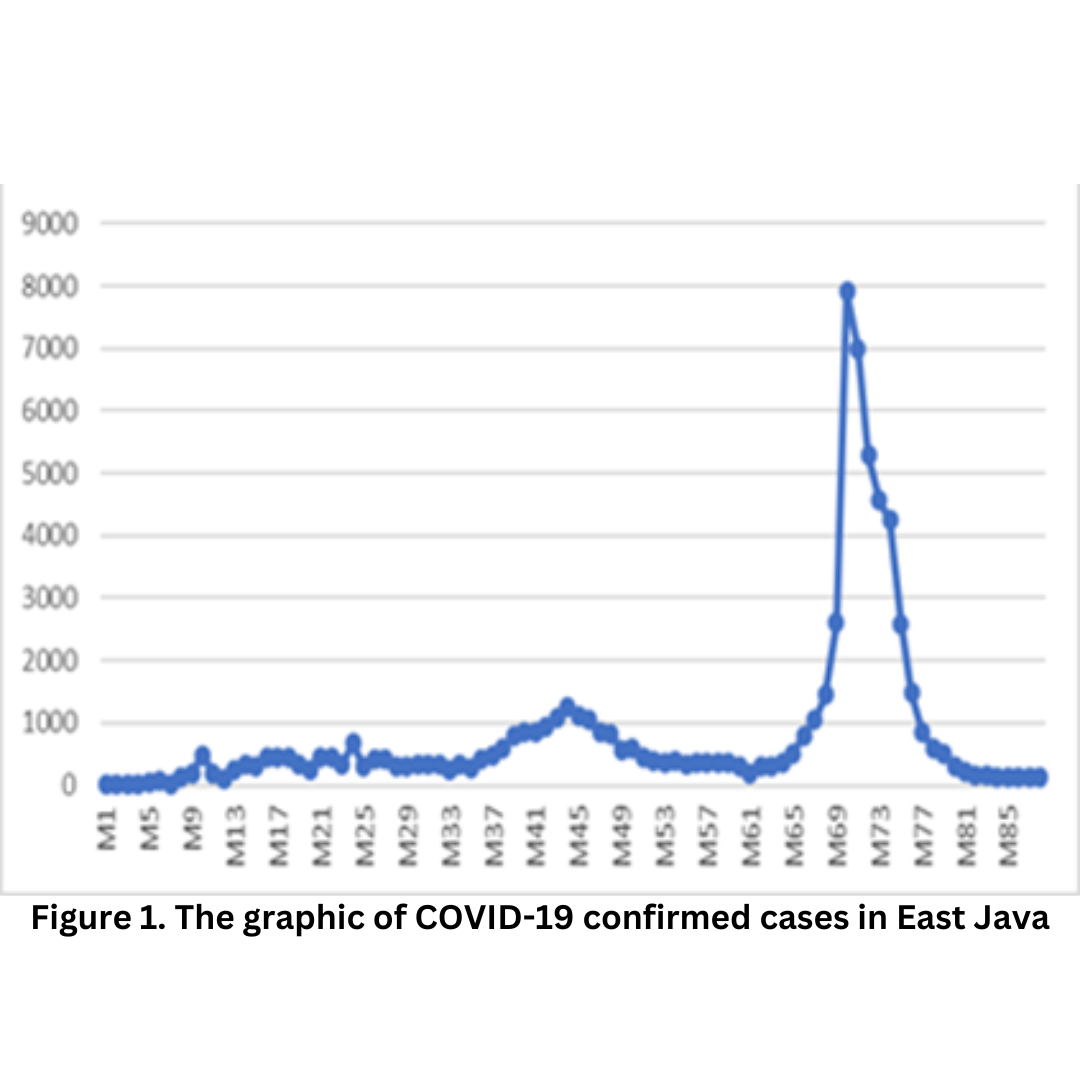FORECASTING OF COVID–19 WITH AUTOREGRESSIVE INTEGRATED MOVING AVERAGE (ARIMA) METHOD IN EAST JAVA PROVINCE
Peramalan Kasus COVID-19 dengan Menggunakan Metode Autoregressive Integrated Moving Average (ARIMA) di Provinsi Jawa Timur

Downloads
Background: The COVID-19 pandemic has had a major impact on the world's health system, including Indonesia. The national health system is facing challenges with increasing cases of COVID-19. With the forecasting of COVID-19 cases, it is hoped that it can be one of the references in dealing with COVID-19 and one form of mitigation in dealing with COVID-19. Purpose: This research aims to predict COVID-19 cases in East Java Province for the coming year using the Autoregressive Integrated Moving Average (ARIMA) method based on patient data from March 2020 to January 2022. Methods: This type of research is analytic. Forecasting future COVID-19 cases using the Autoregressive Integrated Moving Average (ARIMA) method based on COVID-19 data from March 2020 to January 2022. Results: Based on the results of ARIMA analysis, the best forecasting model for confirmed cases of COVID-19 is the model (1:0:1) with AIC values "‹"‹(14.22672), SIC (14.33357), while for cured cases is the model (1:2: 3) with the value of AIC (13.93054), SIC (13.03738), and for the case of death is the model (1:2:1) with the value of AIC (10.76105) and SIC (10.86790). Conclusion: From the results of this study, it is predicted that there will be an increase in COVID-19 cases in July 2022, January 2023 and June 2023.
Pokhrel S, Chhetri R. A Literature Review on Impact of COVID-19 Pandemic on Teaching and Learning. High Educ Futur. 2021;8(1):133–41.
Kim EJ, Marrast L, Conigliaro J. COVID-19: Magnifying the effect of health disparities. J Gen Intern Med. 2020;35(8):2441–2.
Samui P, Mondal J, Khajanchi S. A mathematical model for COVID-19 transmission dynamics with a case study of India. Chaos, Solitons and Fractals. 2020;140:110173.
Wahyuni D. Aplikasi model arima dalam memprediksi jumlah kasus penyebaran covid-19 di provinsi kepulauan bangka belitung. 2021;112–7.
Alabdulrazzaq H, Alenezi MN, Rawajfih Y, Alghannam BA, Al-hassan AA, Al-anzi FS. Results in Physics On the accuracy of ARIMA based prediction of COVID-19 spread. Results Phys. 2021;27:104509.
Siettos CI, Russo L, Siettos CI, Russo L. Mathematical modeling of infectious disease dynamics Mathematical modeling of infectious disease dynamics. 2013;5594.
Murat M, Malinowska I, Gos M, Krzyszczak J. Forecasting daily meteorological time series using ARIMA and regression models. Int Agrophysics. 2018;32(2):253–64.
Zeroual A, Harrou F, Dairi A, Sun Y. Deep learning methods for forecasting COVID-19 time-Series data: A Comparative study. Chaos, Solitons and Fractals. 2020;140:110121.
De Gooijer JG, Hyndman RJ. 25 years of time series forecasting. Int J Forecast. 2006;22(3):443–73.
Warssamo BB, Sciences C. East African Journal of Biophysical and Computational Sciences. 2022;3:58–68.
Singh RK, Rani M, Bhagavathula AS, Sah R. Prediction of the COVID-19 pandemic for the top 15 affected countries : advanced autoregressive integrated moving average ( ARIMA ) Model Corresponding Author : 2020;6:1–10.
Anne WR, Jeeva SC, World T, Organization H, Adhanom T. ARIMA modelling of predicting COVID-19 infections Department of Computer Applications , Sri Krishna College of Engineering and Technology , Tamil Department of Computer Applications , Karunya University , Tamil Nadu , India Keywords Fig 1 . Non Stationari. 2020;
Atmaja LS. Statistika untuk bisnis dan ekonomi. Yogyakarta Penerbit Andi. 2009;
Fanelli D, Piazza F. Analysis and forecast of COVID-19 spreading in China, Italy and France. Chaos, Solitons & Fractals. 2020;134:109761.
Kemenkes RI. Profil Kesehatan Indonesia 2021. Jakarta: Kementerian Kesehatan RI; 2022. p. 172–9.
Nina Widyasari NW, Notobroto HB, Wahyuni CU. Associated risk of death from COVID-19 infection in patients with hypertensive co-morbidities. J Berk Epidemiol. 2021;9(2):130–9.
Nihar M husna, Isfandiari MA. Comorbiditied with the high risk of death among COVID-19 patients: learning for Indonesia. J Berk Epidemiol [Internet]. 2022;10(1):76–85. Available from: https://e-journal.unair.ac.id/JBE/article/view/22693?articlesBySameAuthorPage=2
Faradillah A, Abdi A, Nasrulhaq N. Strategi Pemerintah dalam penanggulangan COVID-19 pada sekretariat satuan tugas penanganan COVID-19 kota Makassar. Universitas Muhammadiyah Makassar; 2021.
Talkhi N, Akhavan N, Ataei Z, Jabbari M. Biomedical Signal Processing and Control Modeling and forecasting number of confirmed and death caused COVID-19 in IRAN : A comparison of time series forecasting methods. Biomed Signal Process Control. 2021;66(February):102494.
Triacca M, Triacca U. Forecasting the number of confirmed new cases of COVID-19 in Italy for the period from 19 May to 2 June 2020. Infect Dis Model. 2021;6:362–9.
Sahai AK, Rath N, Sood V, Singh MP. ARIMA modelling & forecasting of COVID-19 in top five affected countries. Diabetes Metab Syndr Clin Res Rev. 2020;14(5):1419–27.
- Every manuscript submitted to must observe the policy and terms set by the Jurnal Berkala Epidemiologi
- Publication rights to manuscript content published by the Jurnal Berkala Epidemiologi is owned by the journal with the consent and approval of the author(s) concerned. (download copyright agreement)
- Complete texts of electronically published manuscripts can be accessed free of charge if used for educational and research purposes according to copyright regulations.

JBE by Universitas Airlangga is licensed under a Creative Commons Attribution-ShareAlike 4.0 International License.























